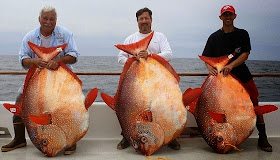Thursday, August 7, 2014
OPAH
Impossible, I think, to share the joy of these three California fisherman at their unexpected one-day catch of three enormous and rare Opah fish. The entire Wikipedia entry for this beautiful fish is found Here.
The Life History section reads:
"Almost nothing is known of opah biology** and ecology. They are presumed to live out their entire lives in the open ocean, at mesopelagic depths of 50 to 500 m, with possible forays into the bathypelagic zone. They are apparently solitary, but are known to school with tuna and other scombrids. The fish propel themselves by a lift-based labriform mode of swimming, that is, by flapping their pectoral fins. This, together with their forked caudal fins and depressible median fins, indicates they swim at constantly high speeds like tuna.
Squid and euphausiids (krill) make up the bulk of the opah diet; small fish are also taken. Pop-up archival transmitting tagging operations have indicated, aside from humans, large pelagic sharks, such as great white sharks and mako sharks, are primary predators of opah. The tetraphyllidean tapeworm Pelichnibothrium speciosum has been found in L. guttatus, which may be an intermediate or paratenic host.[2] The planktonic opah larvae initially resemble those of certain ribbonfishes (Trachipteridae), but are distinguished by the former's lack of dorsal and pelvic fin ornamentation. The slender hatchlings later undergo a marked and rapid transformation from a slender to deep-bodied form; this transformation is complete by 10.6 mm standard length in L. guttatus. Opahs are believed to have a low population resilience."
It would be better, I think, to do what this young man has done for Halloween: trace Opah cut-outs from cardboard, paint them in any of their varying shades (with or without markings) and string them onto a fanciful landlocked pole. That is a happy sight.
** Most green-highlighted terms are Links!



No comments:
Post a Comment